파라인플루엔자 바이러스 감염병, Parainfluenza viral infections

그림 4. 상기도와 하기도
기도를 편의상 상기도와 하기도로 분류한다. Copyright ⓒ 2011 John Sangwon Lee, MD., FAAP
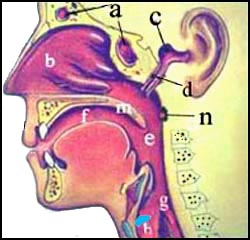
그림 2. 상기도
a-전두동, b-비강, c-중이강, d-이관(구씨관), e-인두, f-구강, g-식도, h-기관, m-연구개, n-아데노이드, o-접형동.
Copyright ⓒ 2011 John Sangwon Lee, MD., FAAP
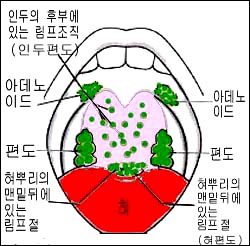
그림 3. 인두와 인두 주위에 있는 림프 조직들
인두 주위에는 아데노이드, 편도, 혀뿌리 부위에 있는 설편도(혀 편도)와 인두강 후벽에 인두 편도 등의 림프 조직이 있다. (파란색 부분으로 표시됐다.)
이들은 비강과 구강을 통해 들어오는 항원. 해로운 이물질과 세균을 잡는 방어기능을 한다.
Copyright ⓒ 2011 John Sangwon Lee, MD., FAAP
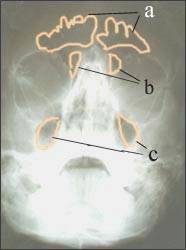
사진 1. 부비동의 X-선 사진
a-전두동, b-사골동, c-상악동.
Copyright ⓒ 2011 John Sangwon Lee, MD., FAAP
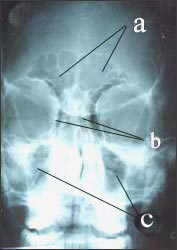
사진 2. 부비동의 X-선 사진
a-전두동, b-사골동, c-상악동.
Copyright ⓒ 2011 John Sangwon Lee, MD., FAAP
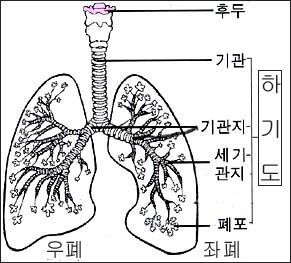
그림 5. 하기도와 폐.
Copyrightⓒ 2011 John Sangwon Lee, MD., FAAP
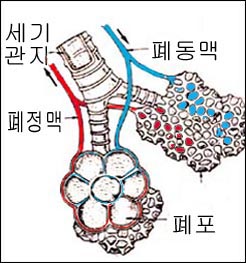
그림 6. 폐포와 모세기관지(세기관지).
Copyrightⓒ 2011 John Sangwon Lee, MD., FAAP
■ 원인 과 증상 징후
-
파라인플루엔자 바이러스는 항원의 종류에 따라 파라인플루엔자 바이러스는 1형, 파라인플루엔자 바이러스는 2형,파라인플루엔자 바이러스는 3형 그리고 파라인플루엔자 바이러스는 4형으로 나누어진다.
-
파라인플루엔자 바이러스는 후두–기관–기관지염(laryngotracheobronchitis/croup), 크루프, 이하선염, 무균성 뇌막염, 뇌염, Guillian-Barre’ 증후군, 중이염, 상기도 감염병, 폐렴 및, 또는 세기관지염의 원인이 될 수 있다.
-
파라인플루엔자 바이러스 1형과 파라인플루엔자 바이러스 2형은 영유아들의 크루프의 주원인이 될 수 있고
-
파라인플루엔자 바이러스 3형은 세기관지염과 폐렴의 주원인이 될 수 있다. 그리고 이하선염, 무균성 뇌막염, 뇌염의 원인도 될 수 있다.
-
만성 폐질환이나 천식을 가지고 있는 아청소년들과 성인들에게 파라인플루엔자 바이러스 감염 병이 생기면 그런 병이 재발될 수 있고 악화될 수도 있다.
-
파라인플루엔자 바이러스 4형 감염병은 드문 줄 알았지만 최근에 증가되고 있다.
-
1, 2, 3, 4형 파라인플루엔자 바이러스 감염을 한번 앓고 난 후에도 면역력이 점점 약화되기 때문에 또 감염되어 앓을 수 있다.
-
직접 접촉이나 비 인두 분비물을 통해서 사람에서 사람으로 감염될 수 있고 오염된 가구 등을 통해서 감염될 수 있다.
-
잠복기는 2~6일이다.
■ 진단
-
병력 증상 징후 진찰소견을 종합해서 이 병을 의심하면 속성 항원 검출 검사, 면역 형광분석 검사, 효소 면역 분석 검사 등으로서 진단할 수 있고 바이러스 배양, RT-PCR 검사로서 진단할 수 있다. 필요에 따라 가슴 X-선 사진으로 진단한다.
■ 치료
-
특효 항바이러스 치료제는 없다. 경미한 경우는 특별한 치료가 요하지 않는다.
-
파라인플루엔자 바이러스 하기도염이 심하게 생겼을 때는 산소호흡, Racemic 에피네프린 에어로졸 치료, 혈관용이나 경구용 Dexamethasone제로 치료하거나 분무 코티코스테로이드 흡입으로 치료한다. 2차 박테리아 감염이 있으면 항생제로 치료한다.
Parainfluenza viral infections

Figure 4. Upper and lower airways Airways are classified into upper and lower airways for convenience. Copyright ⓒ 2011 John Sangwon Lee, MD., FAAP

Figure 2. Upper airway a – frontal sinus, b – nasal cavity, c – middle ear cavity, d – ear canal (bulb canal), e – pharynx, f – oral cavity, g – esophagus, h – trachea, m – soft palate, n – adenoid, o – sphenoid sinus. Copyright ⓒ 2011 John Sangwon Lee, MD., FAAP

Figure 3. The pharynx and lymphoid tissues around the pharynx Around the pharynx, there are lymphoid tissues such as adenoids, tonsils, lingual tonsils (tongue tonsils) located at the root of the tongue, and pharyngeal tonsils on the posterior wall of the pharynx. (Indicated in blue.) These are antigens that enter through the nasal and oral cavity. It acts as a defense against harmful foreign substances and bacteria. Copyright ⓒ 2011 John Sangwon Lee, MD., FAAP

Photo 1. X-ray of the sinuses a – frontal sinus, b – ethmoid sinus, c – maxillary sinus. Copyright ⓒ 2011 John Sangwon Lee, MD., FAAP

Photo 2. X-ray of the sinuses a – frontal sinus, b – ethmoid sinus, c – maxillary sinus. Copyright ⓒ 2011 John Sangwon Lee, MD., FAAP

Figure 5. Lower respiratory tract and lungs. Copyrightⓒ 2011 John Sangwon Lee, MD., FAAP Figure 6. Alveoli and capillaries (bronchioles). Copyrightⓒ 2011 John Sangwon Lee, MD., FAAP
■ Causes and Symptoms Signs
• Parainfluenza virus is divided into type 1, parainfluenza virus, type 2, parainfluenza virus, type 3, and parainfluenza virus, type 4 according to the antigen type.
• Parainfluenza virus can cause laryngotracheobronchitis/croup, croup, mumps, aseptic meningitis, encephalitis, Guillian-Barre’s syndrome, otitis media, upper respiratory tract infections, pneumonia and/or bronchiolitis.
• Parainfluenza virus type 1 and parainfluenza virus type 2 can be the main cause of croup in infants and children.
• Parainfluenza virus type 3 can cause bronchiolitis and pneumonia. It can also cause parotitis, aseptic meningitis, and encephalitis.
• In children and adults with chronic lung disease or asthma, parainfluenza virus infection may recur or exacerbate the disease.
• Parainfluenza virus type 4 infectious disease was thought to be rare, but it is increasing recently.
• Even after being infected with type 1, 2, 3, or 4 parainfluenza virus, immunity is gradually weakened, so it is possible to get infected again. • It can be transmitted from person to person through direct contact or nasopharyngeal secretions and through contaminated furniture.
• The incubation period is 2-6 days.
■ Diagnosis
• If the disease is suspected by combining the history, symptoms, signs, and examination findings, it can be diagnosed by rapid antigen detection test, immunofluorescence assay, enzyme immunoassay test, etc., and can be diagnosed by virus culture or RT-PCR test. Diagnosis is made by chest X-ray, if necessary.
■ Treatment
• There is no specific antiviral treatment. Mild cases do not require special treatment. • In severe cases of parainfluenza virus lower respiratory tract infection, treatment with oxygen respiration, racemic epinephrine aerosol therapy, vascular or oral dexamethasone, or nebulized corticosteroid inhalation. If there is a secondary bacterial infection, it is treated with antibiotics.
출처 및 참조 문헌 Sources and references
- NelsonTextbook of Pediatrics 22ND Ed
- The Harriet Lane Handbook 22ND Ed
- Growth and development of the children
- Red Book 32nd Ed 2021-2024
- Neonatal Resuscitation, American Academy Pediatrics
- www.drleepediatrics.com 제1권 소아청소년 응급 의료
- www.drleepediatrics.com 제2권 소아청소년 예방
- www.drleepediatrics.com 제3권 소아청소년 성장 발육 육아
- www.drleepediatrics.com 제4권 모유,모유수유, 이유
- www.drleepediatrics.com 제5권 인공영양, 우유, 이유식, 비타민, 미네랄, 단백질, 탄수화물, 지방
- www.drleepediatrics.com 제6권 신생아 성장 발육 육아 질병
- www.drleepediatrics.com제7권 소아청소년 감염병
- www.drleepediatrics.com제8권 소아청소년 호흡기 질환
- www.drleepediatrics.com제9권 소아청소년 소화기 질환
- www.drleepediatrics.com제10권. 소아청소년 신장 비뇨 생식기 질환
- www.drleepediatrics.com제11권. 소아청소년 심장 혈관계 질환
- www.drleepediatrics.com제12권. 소아청소년 신경 정신 질환, 행동 수면 문제
- www.drleepediatrics.com제13권. 소아청소년 혈액, 림프, 종양 질환
- www.drleepediatrics.com제14권. 소아청소년 내분비, 유전, 염색체, 대사, 희귀병
- www.drleepediatrics.com제15권. 소아청소년 알레르기, 자가 면역질환
- www.drleepediatrics.com제16권. 소아청소년 정형외과 질환
- www.drleepediatrics.com제17권. 소아청소년 피부 질환
- www.drleepediatrics.com제18권. 소아청소년 이비인후(귀 코 인두 후두) 질환
- www.drleepediatrics.com제19권. 소아청소년 안과 (눈)질환
- www.drleepediatrics.com 제20권 소아청소년 이 (치아)질환
- www.drleepediatrics.com 제21권 소아청소년 가정 학교 간호
- www.drleepediatrics.com 제22권 아들 딸 이렇게 사랑해 키우세요
- www.drleepediatrics.com 제23권 사춘기 아이들의 성장 발육 질병
- www.drleepediatrics.com 제24권 소아청소년 성교육
- www.drleepediatrics.com 제25권 임신, 분만, 출산, 신생아 돌보기
- Red book 29th-31st edition 2021
- Nelson Text Book of Pediatrics 19th- 21st Edition
- The Johns Hopkins Hospital, The Harriet Lane Handbook, 22nd edition
- 응급환자관리 정담미디어
- Pediatric Nutritional Handbook American Academy of Pediatrics
- 소아가정간호백과–부모도 반의사가 되어야 한다, 이상원 저
- The pregnancy Bible. By Joan stone, MD. Keith Eddleman, MD
- Neonatology Jeffrey J. Pomerance, C. Joan Richardson
- Preparation for Birth. Beverly Savage and Dianna Smith
- 임신에서 신생아 돌보기까지. 이상원
- Breastfeeding. by Ruth Lawrence and Robert Lawrence
- Sources and references on Growth, Development, Cares, and Diseases of Newborn Infants
- Emergency Medical Service for Children, By Ross Lab. May 1989. p.10
- Emergency care, Harvey Grant and Robert Murray
- Emergency Care Transportation of Sick and Injured American Academy of Orthopaedic Surgeons
- Emergency Pediatrics A Guide to Ambulatory Care, Roger M. Barkin, Peter Rosen
- Quick Reference To Pediatric Emergencies, Delmer J. Pascoe, M.D., Moses Grossman, M.D. with 26 contributors
- Neonatal resuscitation Ameican academy of pediatrics
- Pediatric Nutritional Handbook American Academy of Pediatrics
- Pediatric Resuscitation Pediatric Clinics of North America, Stephen M. Schexnayder, M.D.
-
Pediatric Critical Care, Pediatric Clinics of North America, James P. Orlowski, M.D.
-
Preparation for Birth. Beverly Savage and Dianna Smith
-
Infectious disease of children, Saul Krugman, Samuel L Katz, Ann A.
- 제4권 모유, 모유수유, 이유 참조문헌 및 출처
- 제5권 인공영양, 우유, 이유, 비타민, 단백질, 지방 탄수 화물 참조문헌 및 출처
- 제6권 신생아 성장발육 양호 질병 참조문헌 및 출처
- 소아과학 대한교과서
Copyright ⓒ 2014 John Sangwon Lee, MD., FAAP
“부모도 반의사가 되어야 한다”-본 사이트의 내용은 여러분들의 의사로부터 얻은 정보와 진료를 대신할 수 없습니다.
“The information contained in this publication should not be used as a substitute for the medical care and advice of your doctor. There may be variations in treatment that your doctor may recommend based on individual facts and circumstances.
“Parental education is the best medicine.”